Evolution (How do life form change over time ?)
Concept of Evolution :
The word ‘evolution’ means change of life forms over of wide variety of plants and animals on earth along with the. remains of dead or extinct organisms that lived in remote past, arises questions—how and from where all these organisms came into existence.
Evolution is a process of gradual unfolding of the new organisms from the preexisting primitive organisms through slow and steady changes. Thus enormous variety of plants and animals have come to exist on earth as a result of constant evolutionary process.
Evolution is the centralmost important idea in.Biology that complex living organisms evolved on earth from relatively simple ones. Hence, evolution is the cause of biodiversity on earth.
In fact, biodiversity (diversity of living organisms on earth) is due to genetic mutation.
That’s why, it is said, “Mutation is the raw material of evolution”.
Definition: Evolution is a slow but gradual progressive process by which a simple form of organism gradually becomes complex in course of time by the process of reproduction, variation and heredity resulting into origin of new species.
Evolution and Adaptation NCERT Class 10 Notes
Read and Learn More Class 10 Science
Origin of life
Evolution (latin,evolvere=unfold) means ‘unfolding of life’ like the opening of a floral bud into a flower. probable steps of chemical origin of life (theory of abiogenesis)
are as follows:
Scientists believe that the earth at its time of formation was like a ‘fireball’. There were innumberable atoms of different elements like hydrogen, oxygen, carbon, nitrogen, sulphur, phosphorus etc.
Free atoms combined to form H2, N2, H2O (water vapour), CH4 (methane), NH3, CO2 etc. H2 combined with O2 to from H2O and there was no free O2. H2 was burning and O2 helped in burning.
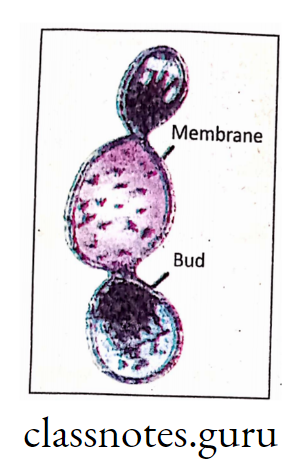
Thus primitive earth was without free O2 (reducing atmosphere). [However, present day earth is with free O2 (oxidising atmosphere)]. H2 also combined with N2 to form IMH3. Probably H2O and NH3 were first compounds on primitive earth.
Early inorganic molecules combined together to form simple organic molecules like glucose, amino acids, glycerol, fatty acids etc. These organic molecules assembled together to form microsphere that could grow by budding.
As earth started slowly cooling down, water vapour condensed to form cloud from where rainfall started and thus initiated water cycle. Rainwater was flowing from higher to lower level—thus formed fountain, hilly river, big river, sea and finally ocean.
During this downward flow of water, various salts, minerals and other chemical compounds get mixed with water and carried to oceanic water.
During rainfall, there was definitely thundershower. Thunder or lightning caused high voltage electric current that could be one of the major sources of external energy for various chemical reactions.
In this way probably a variety of complex organic molecules like protein, fatty acids, nucleotides etc. were formed and accumulated in sea or oceanic water.

Theory of ahiogenesis or chemical origin of life (Oparin and Haldane, 1923)): Definition: The formation of complex organic molecules from simpler inorganic molecules, through chemical reactions in the oceanic water during early history of earth is known as chemical evolution.
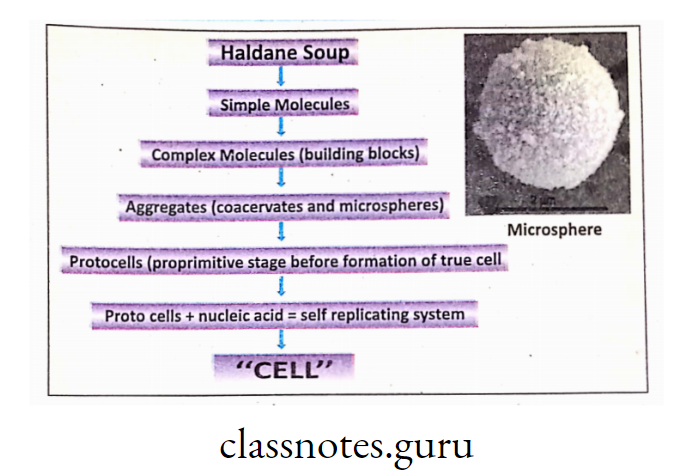
Experiment of Miller and Urey :
Stanley Miller and Urey (1953) provided an experimental proof of the theory of abiogenesis. (Miller was student of Urey). They created a laboratory condition similar to probable early earth.
Experimental procedure :
Water in a closed small flask was taken (that resembled primitive sea). Water was heated to produce water vapour that moved into a second flask placed at a higher level.
Second big flask contained a mixture of methane (CH4); ammonia (NH3) and hydrogen (H2) gases in the ratio of 2:2:1. This resembled the primitive atmosphere.

The gas mixture in the upper flask was subjected to high voltage electric discharge/ current (60,000 volts) at 800°C temperature from tungsten filament. This resembled
vigorous lightning and violent electrical storms in early earth.
The mixture was then condensed in raining water and dissolved molecules were collected at the bottom of the condenser. Miller continued the experimental set up and procedure for one week.
Samples formed in the condenser were collected and analysed.
Observation: Miller identified a variety of organic molecules like some amino acids (alanine, glycine etc.), long chain carbohydrates, formaldehyde etc. in the formed samples.
Inference: F.rom the above observation, Miller concluded that organic molecules might have been synthesized abiotically in early earth probably by the energy of high
voltage electric current of thundershower and other external sources of energy like solar radiation etc. (There was no ozone layer in pre-historic earth).
Therefore, the “theory of abiogenesis of origin of life” has been proved experimentally.
Major evolutionary events: Evolution has involved gradual transformation from simple, unicellular, underdeveloped form to complex multicellular, well differentiated forms of plants
and animals.
Major evolutionary events can be explained with a schematic diagram as follows :
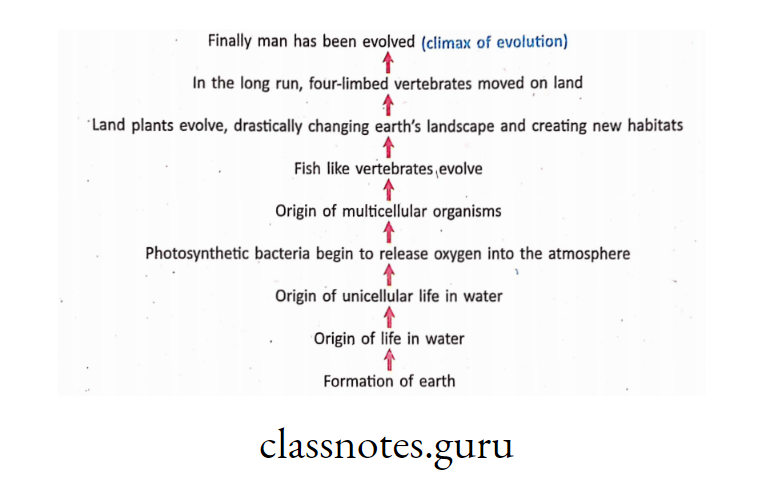

Theories of Evolution :
A number of theories have been put forward in order to explain evolutionary process taking place in plants and animals. However, Linnaeus proposed a scientific explanation of this evolutionary process, stating that, each and every species originates or evolves from some preexisting forms.
The theories of Evolution were put forward by Jean Baptiste de Monet Lamarck and Charles Robert Darwin. These theories are known as Lamarckism and Darwinism respectively.
Lamarckism
Jean Baptiste de Monet Lamarck was born at Bajastin in France in 1744. His theory on evolution was published in his book “Philosophic Zoologique” in 1809. His theory is known as ‘Theory of Inheritance of Acquired Characters’, and popularly known as Lamarckism. Lamarck proposed two ideas in order to explain his theory.

The ideas are : (i) Law of use and disuse of parts and (ii)Inheritance of acquired characters.
Class 10 Science: Evolution and Adaptation Key Concepts
Lamarck’s theory :
Continuous increment in size—All living organisms increase in size due to growth.
Conscious effort and Environmental effect—All organisms are influenced by environment. So change in environment brings about changes in organisms that develop new
demand to produce new structures in the organisms.
Thus the organism can adapt in the changing environment.
Use and disuse of organs—Lamarck proposed that by constant use; a particular organ in organisms gradually develops more and more whereas by constant disuse, the organ
becomes smaller in size and ultimately degenerates.
Inheritance of acquired characters—Due to continuous increment in size, environmental effect together with use and disuse of organs, new characters may develop in an organism
known as acquired characters.
These characters are inherited to successive generations. Gradually these acquired characters are accumulated over the generations to give rise to new species. . .
Examples in favour of Lamarckism: Lamarck explained his theory citing following examples :
Effect of use::
Long neck of giraffe—The ancestors of present day giraffe had very short neck and forelimb like horse. They used to live in the places having poor surface vegetation. So they tried to stretch their neck and forcllmb in an effort to reach to the foliages of tall trees.
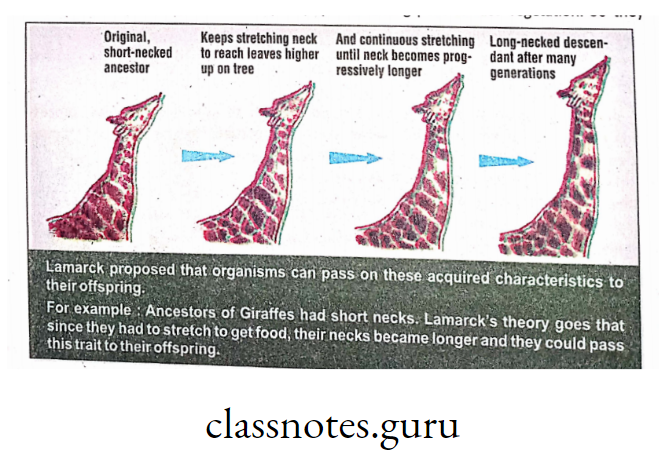
This resulted into little longer neck that was inherited to next generation. Over the generations by similar effort the neck and forelimb gradually stretched more and more thus present day giraffe with long neck and forelimb has been evolved.
Webbed feet in ducks –Oucks swim in water. All the fingers are covered by a flap of skin called webbed feet that help in swimming. This proves that because of constant use
of fingers for swimming, webbed feet was evolved.
Effect of disuse :
Loss of limbs in snake-The present day snakes are without any forelimb or hindiimb. But the fossil records proved that snakes in the prehistoric time had limbs. (Even present
day snakes like Boa, Python have vestigial pectoral girdle and pelvic girdle though they limbless).
Snakes used to crawl on the abdominal muscle (since they had very long body). So their limbs became useless (constant disuse), gradually degenerated, became vestigial and ultimately disappeared.
Criticism against Lamarckism :
Germplasm theory (Weismann)—August Weismann, a German biologist strongly criticised Lamarck’s theory. He experimentally cut off the tails of rats for nearly 22 generations
and allowed the tailless rats to breed, but no tailless offspring was born.
If tailless condition is an acquired character, it was not inherited to any generation. (So acquired character does not always inherit.)
Weismann proposed that in the body of organisms, there are two types of protoplasm germplasm (protoplasm of germ cell) and somatoplasm (protoplasm of somatic cell). Only
germplasm is inherited from one generation to next but not the somatoplasm.
Neo-Lamarckism :
According to modern concept of genetics, Lamarck’s theory has been newly modified called Neo-Lamarckism, that can be stated as follows :
- Genes are responsible for ail characteristics of an organism.
- If by constant use and disuse, a genetic mutation develops, then only an acquired character may rise newly.
- For inheritance of acquired character, the mutation must be present in germ cell (germplasm) because only germ cells are inherited from one generation to next.
Darwinism
Charles Robert Darwin (1809-1882) was born in England on 12th February, 1809. He published his theory of evolution in his famous book, “On the origin of species by means of natural selection”.
The theory of evolution is known as The Theory of Natural Selection! It is also called Darwinism.
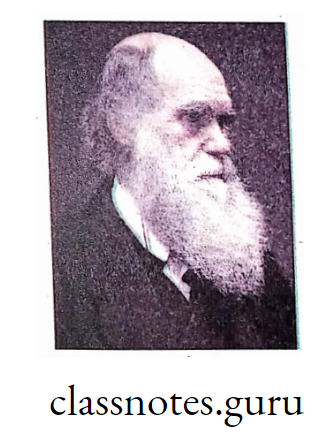
Darwin made arrangements for his assignment scientist in a voyage for exploration in the famous historical H, M. S. Beagle. The ship went on voyage on 27th December, 1831. It visited many islands of the Atlantic Ocean and South Pacific and some coasts of South America.
The Beagle returned safely on 2nd October, 1836 after 5 years of extensive survey. Darwin took extensive notes and collected lot of specimens of the Galapagos island and other places.
The name of the island was Galapagos (Spanish word for tortoise) as there were plenty of giant tortoise. Darwin observed Giant tortoise, Iguanas (Reptiles), Insects, Lizards, and thousands of birds (called Finches).
He stated his observations in his book entitled, “On the origin of species by means of Natural Selection” in 1859..
Darwin’s theory of Natural Selection: The theory is a mixture of some observations and inferences drawn from it.

Principles of Darwin’s Theory of Natural Selection are discussed as follows :
Rapid multiplication and over production—Every living organisms multiply by the process of reproduction. Thus they increase in number in geometric progression.
Prodigality of production—Even though all species produce a large number of offsprings, population remains more or less constant. This means more youngs are produced than to survive.
For example, a female Ascaris (round worm) produces about 7,00,000 eggs in 24 hours; a salmon fish produces about 28,00,000 eggs in one breeding season; an oyster produces 114,000,000 eggs and so on.
All these eggs will not hatch or grow upto adult. So many eggs are eaten up by other predators; some of eggs may be decomposed; some offsprings may be eaten up by other predators of food chain etc.
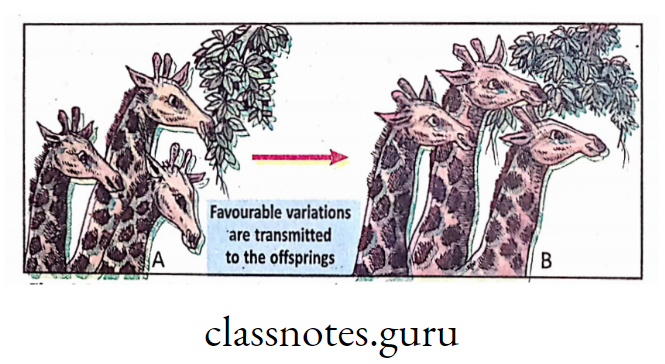
Evolution in Nature: Class 10 Science Notes
Constancy of food and space—Amount of food and space in a particular area remains more or less constant although the organisms increase in number.
Struggle for existence—A struggle between members of same species and of different species for food and Space is called struggle for existence. Usually there are three types of struggle found in nature, such as—
- Intra-specific struggle—It is the struggle for food and space between the organisms of their own kind,
- Inter-specific struggle—It is the struggle for food and space between the individual of different species,
- Environmental struggle—It is the struggle against physical factors of the environment, like excess of moisture, heat, cold, rainfall and against geological conditions.
Variation—No two organisms are exactly same (except the identical twins). So, there are differences among the organisms and these differences are called as variation. Darwin
proposed that these variations are continuous (gradual).
Some variations are advantageous and can adjust better with the environment than that of others and these variations (adaptive features) are known as favourable variation that are inherited generation after generation.
Survival of the fittest—The individuals, which can environmental conditions are successful in struggle for existence. Struggle for existence eliminates the unfit individuals. The fit individuals possessing favourable variations survive and reproduce. So there will be survival of fittest and elimination of unfit.
Natural selection—The individuals possessing favourable variation enjoy a competitive advantage over the others. They are better adapted to their environment, survive more and
produce more offsprings.
The individuals with disadvantageous variation fail to adapt properly to their environment and therefore get eliminated by natural selection.
Inheritance of useful variation and origin ofmew species (Speciation)—The favourble variations of selected organisms gradually accumulate by reproduction generation after
generation and ultimately this may give rise to a new species known as “Origin of Species”.
Examples in favour of Darwinism :
According to Darwin’s theory of Evolution, the ancestors of giraffe showed necks and forelimbs of different lengths. As giraffes were forced to reach leaves on tall trees, the giraffes with longer neck and forelimbs had advantage over others.
Thus these giraffes had better chances of survival (fit) and were selected by nature. When they reproduced, the offsprings possessed the same advantageous variation. This explained how present day giraffes with long neck and forelimbs came into existence.
Giraffes with short neck and forelimbs (unfit) starve and die. This example justifies the idea of survival of fit and elimination of unfit.
Criticism against Darwinism :
Darwin had no idea about chromosome, DNA, gene, mutation. So, he could not explain the cause of variation, mechanism of inheritance of variation. On the contrary, he proposed
theory of pangenesis that was not accepted by the scientists.
Neo-Darwinism: In the light of modern genetics, Darwin’s theory has been newly interpreted known as Neo-Darwinism (also called as synthetic theory of evolution), which may be explained briefly as follows :
- Genes are responsible for all characteristics of an organism.
- Due to genetic mutation, new characteristic (variation) may develop which is transmitted through germ cell (reproduction) from one generation to next.
- Accumulation of mutation by reproduction over the generations may give rise to origin of new species.
Comparison between Darwinism and Lamarckism :
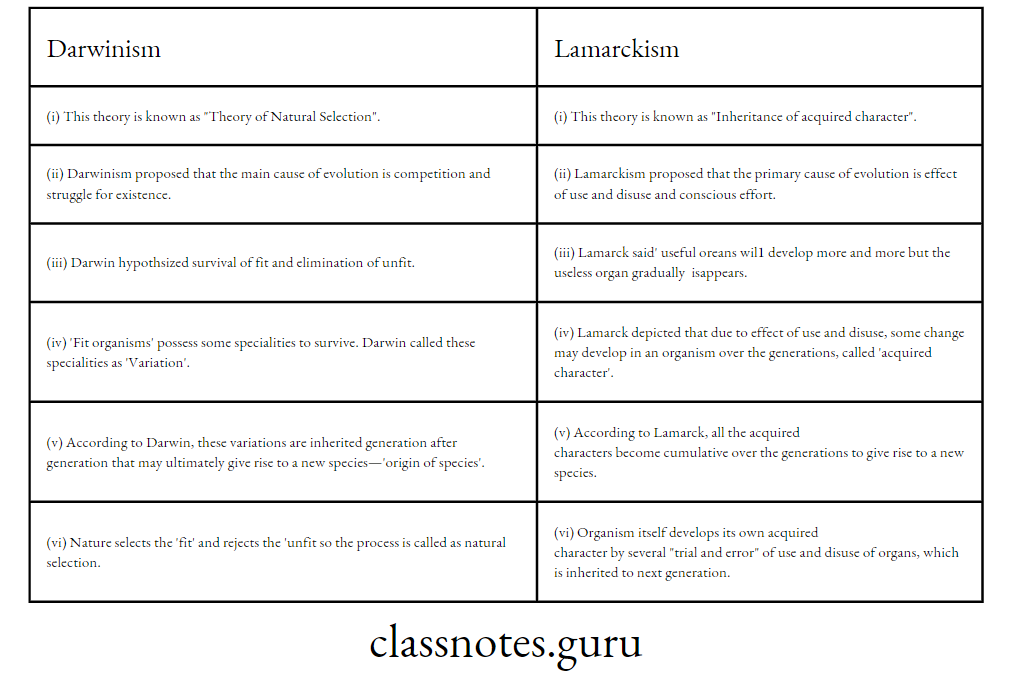
Evidences for the theory of Evolution: (What are the evidences of evolution ?)
Palaeontological (Gr. Palaeos = ancient) evidences of evolution :
Palaeontology is the branch of science (Geology) that deals with the fossils. Thus palaeontology links geology with biology.
Definition of Fossil: The fossils are the remnants of any hard part of the body of prehistoric organisms or its impression on any layer of earth strata, that are preserved by nature.
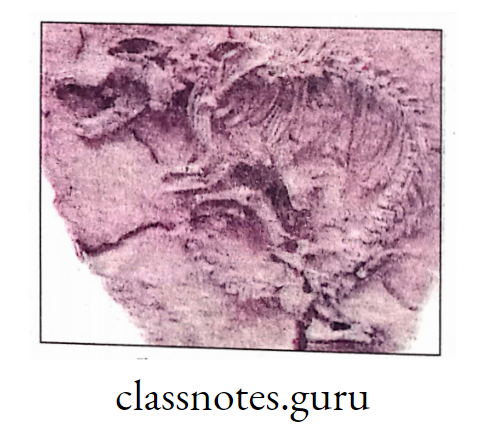
Importance of fossils :
- Fossils are important means for identifying rock’s strata.
- Fossil gives us evidence of steps of evolution,
- Age of fossils reflects the age of evolution of a particular organism,
- Fossil reflects the idea of structure and function of prehistoric organisms,
- Fossil also provides some idea about possible cause of extinction of the prehistoric organisms.
Fossil history of horse :
Many complete fossils of horse have been discovered from different parts of the earth, Modern horse have reached the highest grade of cursorial adaptation. Whole of structural
organisation of horses is primarily due to food-getting mechanism and to attain speed. It took nearly 60 million years to complete the phylogeny of horse. The first fossil horse was
discovered in USA.
Continuous change of character during evolution is referred to as evolutionary trend Major evolutionary trends of horses were-
- Increase in size.
- Lengthening of limbs and feet.
- Reduction of lateral digits.
- Increase in length and thickness of the third digit.
Evolutionary history of horse may be briefly described as follows :
Stage 1—Eohippus: First fossil of horse is named tohippus (‘dawn horse’) that was discovered from North America. It was evolved nearly 60 million years ago.The size of the
animal was like a fox. It was 11″ high at the shoulders, with short head and neck.
The forelimb was with four complete fingers (2, 3, 4 and 5) and one it of finger 1 whereas hindlimb was with three functional fingers (toes)-2, 3 and 4 with two splints of finger 1 and 5. (Splints are vestigial side fingers of horse).
Evolutionary Theory and Adaptation: NCERT Class 10 Science Notes
Stage 2— Meso’nippus : Mesohippus evolved from Eohippus. This is intermediate horse, evolved nearly 40 million years ago. The size of the animal was like that of present day sheep, about 24″ high at the shoulders.
Forelimb with three fingers (2, 3 and 4) and 1 splint of finger 5 whereas hindlimb had three fingers (2, 3 and 4) where finger 3 was longest and supported most of body weight.
Stage 3— Merychippus: This was evolved from Mesohippus, nearly 25 million years ago, about 40″ high at shoulders, with longer neck. Both forelimb and hindlimb had three fingers where middle finger (3rd) was longest and supported entire body weight.
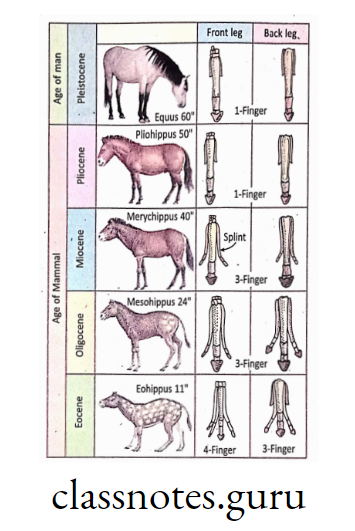
Stage 4—Pliohippus: Pliohippus evolved from Merychippus about 10 million years ago. It was nearly 50″ high at the shoulders. Both forelimb and hindlimb had strong complete finger 3 with splints of 2 and 4. Thus Pliohippus might be considered as first onetoed horse.
Stage 5— Equus: This is modern horse that was evolved from Pliohippus nearly 1 million years ago in North America and later spread throughout the world (except Australia). It is
about 60″ high at the shoulders with a long head and neck. Each forelimb and hindlimb has one very strong complete finger (finger 3) with two splints.
Therefore the line of progression of evolution of horse is
Eohippus —> Mesohippus —> Merychippus —> Pliohippus —> Equus (Modern horse)
Evidences from comparative anatomy and morphology :
Homologous Structures: Definition: The organs that have similar origin and structure but differ in shape, size and functions are called homologous organ.
Examples :
Forelimb of man, whale, bat, bird. The forelimb of all these animals have same basic structure but different shape and functions. In man, forelimb is used for grasping, in whale for
swimming (paddler/flipper), in bat for flight (patagium), in bird for flight (wings).
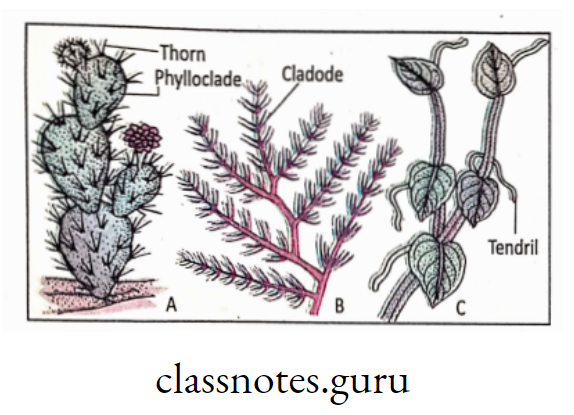
Tendril of pea plant and spine in cactus. Both of them are modified leaves but tendril helps to provide support whereas spine helps in protection, reduces transpiration.
Analogous organs/structures : Definition:The organs having different origin and structure but perform similar function are called analcgous organ.”
Examples :
Wings of birds and wings of insects. The have different structure but perform same function of flight.
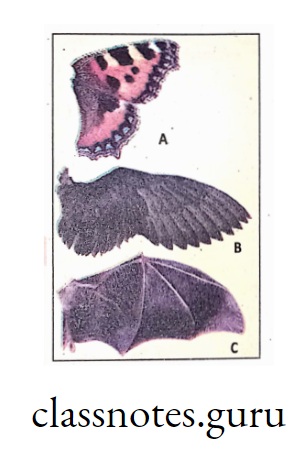
Phylloclade in cactus (modified stem) and stipules in pea plant; Tendril in pea plant (modified leaf) and tendril in passiflora (modified axillary bud of stem)
Differences between Homologous and Analogous organs :

Convergent evolution: Definition:lt is the process where different groups of organisms independently evolve analogous structures having similar functions to adapt in similar
environment Analogous structures are the result of convergent evolution.
Example: In aquatic environment, so many animals are living, such as, Invertebrates (e.g. prawn, lobster), so many Fishes, Amphibia (e.g. toad and frog), Reptilia (e.g. crocodile, turtle), birds (e.g. ducks), Mammals (e.g. whale, dolphin) etc.
Evolution and Natural Selection: Class 10 Science Notes

Any aquatic animal must have the common function of swimming, steering and balancing. All these animals have developed different structures to serve those common functions.
Divergent evolution: Definition:lt is the process where similar groups of organisms develop different functional structures to adapt in different environment. Homologous
structures are the result of divergent evolution.
Example: The forelimb of man, tiger, whale and bat have same basic structural plan—i.e. same type of bones, muscles etc. But the forelimbs of these animals have different shapes
and functions.
In man, hands are used for various functions as well as grasping; in tiger for running as well as catching the prey; in whale the forelimb is modified into flipper or paddler for swimming; in bat it is modified into patagium (wing) for flight.
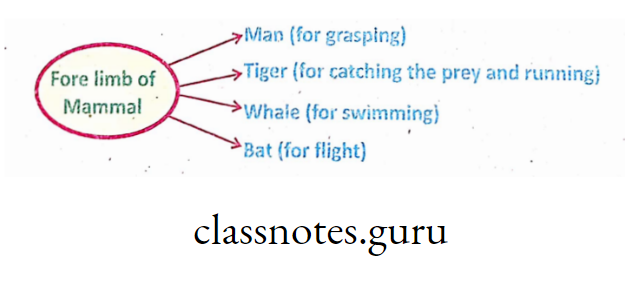
Differences between Convergent and Divergent evolution :

Vestigial organs: Definition: The organ which is useless and functionless but present in the body in much reduced form is known as vestigeal organ. (The organ is believed to be
fully formed and functional in the ancestor).
How does vestigial organ justify evolution?
These rudimentary functionless organs found both in animals and plants are evidences of organic evolution. Biologists believe that these vestigial structures can be explained only on the basis that, previously (in the ancestors) these structures were present in their full-form, but now they have turned completely functionless.
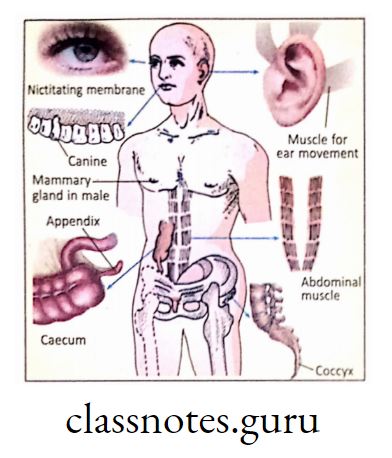
The vestigial organs that have lost their adaptive functions still continue to persist in a reduced condition. It seems as if ition is a filterin and by its automatic operation useful structure will develop more and more whereas useless structure will be gradually atrophied and ultimately disappear in the long run.
Examples of vestigial organs :
Some examples in animals—Weidersheim has listed nearly 100 such characters in human, few are mentioned here.
Vermiform appendix—The vermiform appendix of the caecum of man is perhaps the best example of vestigial organ. It serves no useful purpose in man. It often becomes infected and inflammated and has to be removed by surgical operation.
Adaptations in Organisms: NCERT Class 10 Science Notes
In other primates, however, this structure is much longer. In the rabbit, for example, the appendix of the caecum is a functional part of the digestive system. The appendix of man, hence, is understandable as a degenerating inherited structure from his ancestor.
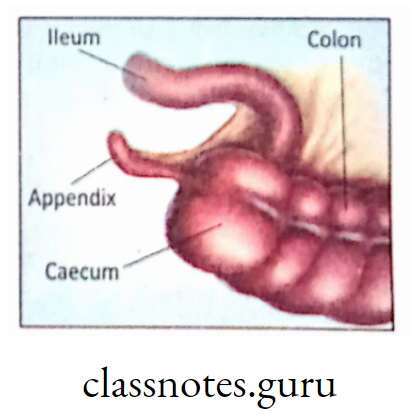
Nictitating membrane- It is the rudimentary structure present in the inner corner of the eye. It Is another example of a vestigial structure in man. This is the remnant of the fully functional nictitating membrane of other vertebrates. These structures, however, has no function in man.
Other vestigial organs- In human being, there are a nurmber of vestigial organs such as —a vestigial tail or coccyx at The end of vertebral column, mammary gland in male/segmental abdominal muscle, third molar teeth, muscles at the back side of the pinna, etc.
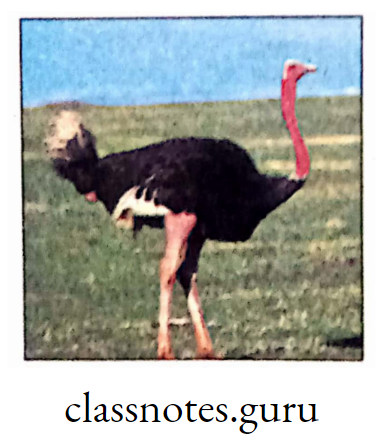
It has been observed that cow, dog and horse for example, are able to move their pinna for the more efficient detection of sound. In man the muscles necessary to move the pinna are rudimentary and functionless.
Some examples of vestigial organ in plants :
Cutin-covered stomata present on the stems of the Cacti.
Sterile stamen (staminode) (only filament without anther) of Mango,Canna, Cashew nut flowers, etc.
Sterile carpel in Coconut flower.
Functionless synergids and* antipodals ‘n the embryo Sac of the mature megagametophyte of the angiosperms.
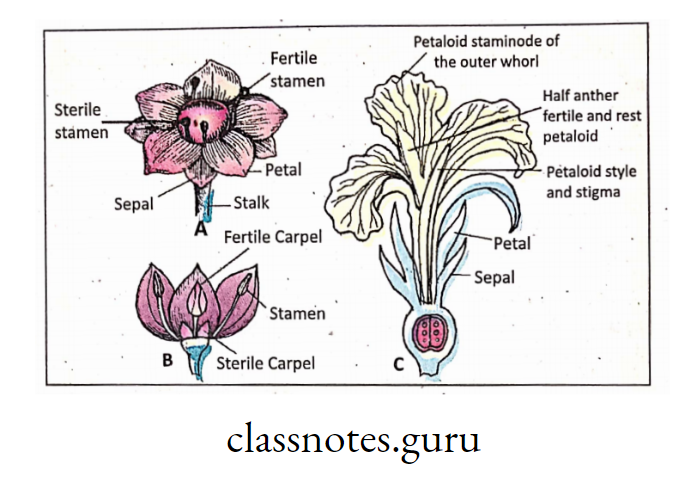
Useless flagella on the-cycad sperms (that are passively transported to the egg), etc.
Structure of vertebrate heart: Heart shows interesting homologies,
In fish— Two chambered heart Of fish (venous heart) consists of one auricle (atrium) and one vertricle only. It is transformed into four chambered heart in birds and mammals through the intermediate forms like amphibians and reptiles, the two chambered heart of fishes is not only simple, but also efficiently adapted to the aquatic environment.
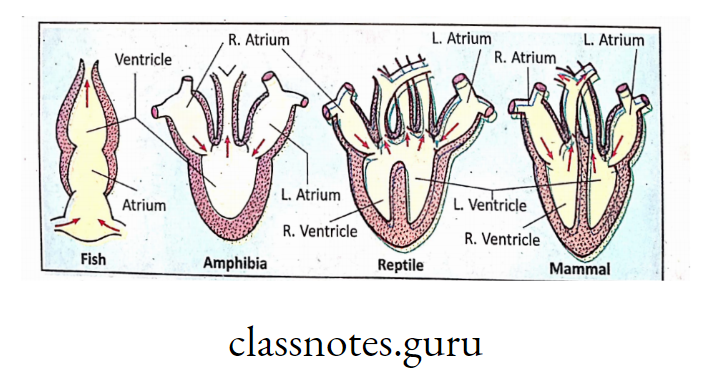
ln amphibia—With the change of habitat the amphibian heart became three chambered to prevent the admixture of the oxygenated (arterial) and deoxygenated (veneous) blood. But even then, it was, not sufficient to serve the purpose.
In reptiles—The heart of reptiles is basically three chambered, but the single ventricle is partially partitioned by a vertical septum. Thus it is also called 3} chambered heart. (But in crocodiles the ventricular partition is complete but there is an opening in the heart called Foramen of Panizza through which oxygenated and deoxygenated blood get mixed.)
In birds and mammals—The ventricular partition is complete, thus the heart is completely four chambered. Due to this arrangement, the arterial and venous blood remain completely separated.
Above examples of evolution of heart in vertebrate series (Fish, Amphibia, Reptiles, Birds and Mammals) signified that simple form of heart in fish (2-chambered) gradually becomes
complex (4-chambered) in Birds and Mammals for greater advantage—such that poikilothermal or cold-bloodedanimals (Fish, Amphibia and Reptilia) become homeothermal or warm-blooded animals (Birds and Mammalia) due to complete separation of oxygenated and deoxygenated blood.
Evidences from /Comparative embryology :
Embryology deals with the embryonic developmental stages since zygote till birth of the young one. (newborn). These evidences are based on comparative study of the embryos of various animals.
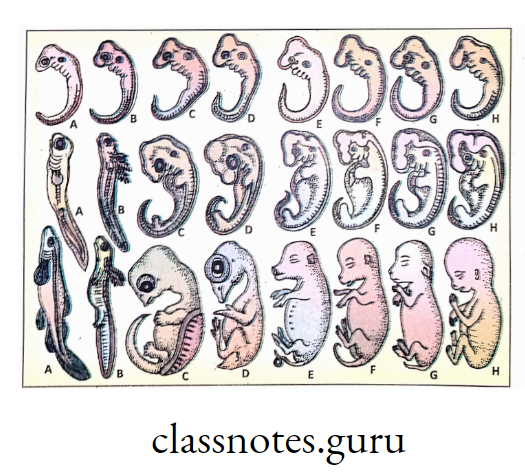
Evidence of Evolution: Fossils, Embryology, and Comparative Anatomy
If a comparative study is made with embryos of different vertebrates (such as fish, amphibia, reptilia, aves and mammalia), striking similarity is observed among the embryos as follows :
- Similar external branchial grooves (visceral clefts) in the pharyngeal region.
- Presence of a series of internal paired gill pouches.
- Presence of segmental myotomes (muscle blocks) in the tail-like structure.
Survival strategies: Adaptation
Introduction: A wide variety of living organisms are present in this planet Earth. They survive in a vast range of habitats. By constant interaction with environment, they survive
through adversities.
In order to gain maximum benefit from surrounding environment to ensure their survival, their long interactions with the environment bring about.certain morphological, anatomical, physiological, and behavioural changes.
The favourable changes which help an organism to thrive in their habitat are called adaptive features and the process bringing about their adjustment to their surroundings is called adaptation.
Cumulative adaptive features over the generation may lead to origin of new species called evolution.
The living organisms react directly to their environments in which they grow and live. As the environment is constantly changing, in order to survive in that changed condition, living
organisms may undergo certain structural modifications, otherwise there is a chance of their extinction.
These external and internal structural changes enable the living organisms to survive in their struggle for existence on earth.
Relation between adaptation and evolution :
The adaptive features enable the organisms to make the best of the conditions under which it lives. Organisms which are not able to adapt themselves to particular environment gets
eliminated, as they become weaker and weaker with successive generations, and gradually become extinct.
Organisms adapting themselves to new environment, may undergo genetic changes (mutation) which may result in production of some new varieties of organisms.
The variety of living organisms we see today is a consequence of evolution, where each variety is being modified gradually by adaptation for living in its own way. Thus adaptation is the cause and evolution is the effect/outcome.
Behaviour and adaptation : (Why is behaviour important in the process of evolution ? How does adaptation evolve in the population of an organism ?)
An adaptation can bestructural which means it is a physical part of the organism but an aptation can also bebehavioural which means the way an organism acts.
A behaviour is an action carried out by an organism under the control of the nervous system in response to an environmental stimulus (cue) or to the actions performed by an organism.
A cue (stimulus) may be an odour (eg. pheromone), sound (eg. call of Cuckoo) or visual signal behaviour is what an animal does. Behaviour allows animals to survive and reproduce and is, thus, extremely important (critical) to evolutionary process.
Behavioural adaptations include activities that help an animal to survive. Examples-Special behaviour (some animals live in groups eg. honey bee, ants etc. called social insect );Protec
behaviour (that helps to protect the animal, eg. opossum plays dead after watching beer), animal migration (for better climate, food, safe place to live and reproduce).
Behavioural adaptations can be inherited or learnt eg. swarming behaviour of honey bee. Adaptation to extreme climate (eg. cold like snowy region, dry like desert etc.) needs special
behaviour and physiology.
Behavioural pattern describes an animal’s dominant way of life eg. arborea’ An’ma* like monkey lives in trees, noctural animals like owl are active at night and so on.
Adaptive features develop because of genetic mutation. Some mutations help an organism to survive better than others (nonmutants). Adaptive character or adaptation evolve in a
population of organisms by the process of natural selection.
Definition: Proper structural, functional, physiological and behavioural modifications of an organism over generations in response to environmental change in order to survive and
reproduce is called adaptation.
Examples of adaptation :
(How does adaptation occur in organisms living in different environments ?)
Morphological adaptive features :
CACTUS (Conversion of leaf into spine or reduction in the number of leaf) :
In cactus, leaves are small, much less in number, scaly and often modified into sharp pointedsP’nes- This modification helps in checking loss of water by transpiration (since in desert, there is acute scarcity of water). Spines also help indefensive mechanism of the plant.

In some xerophytes, leaves are thick succulent and the epidermis is covered by a waxy coating.
Swim Bladder Of Fish :
Swim bladder of bony fish is a thin walled sac, elongated in shape and filled with gases. It is located in the dorsal side of the body cavity below the vertebral column.
The Swim bladder (or air bladder) consists of two chambers, of which the anterior one is smaller than the posterior. The bladder is supplied with blood capillaries called retia mirbbilia
or red gland. The swim bladder is connected with the gut by a small duct called pneumatic duct.

The bladder is called hydrostatic organ. When the fish absorbs gases into the sac, body becomes lighter in weight, buoyancy increases and the fish floats up. On the contrary, if
gases go out of the air sac, body becomes heavier in weight, buoyancy decreases and the fish sinks down. Contraction of body muscle causes increase or decrease of volume of air in the sac allowing the fish to swim freely at different desired depth of water.
Air Sac Of Bird :
Lungs of flying birds (e.g. Pigeon) are supplemented by thin wall sacs called air sacs. There-are generally nine major air sacs and four minor air sacs. In the air sac, there is no alveoli. Hence there is no gaseous exchange in the air sac but it can only store warm air.
This air makes the body light in weight that helps to increase buoyancy for flight in air ocean.

Extra energy is required for volant adaptation that comes- from double respiration. The lungs in bird are comparatively smaller in size and contain alveoli where gaseous exchange takes place. During inspiration, air comes in contact with alveoli causing first gaseous exchange and then air enters into air sacs.
During expiration, air goes out of air sac and flows over the alveoli when air comes in contact with the alveoli for the second time causing second gaseous exchange. Thus, in one complete breathing cycle (inspiration and expiration), gaseous exchange takes place twice.
So the process is called double respiration. This provides increased functional efficiency of lungs, greater oxygen supply, higher rate of respiration and energy production—that are all useful for flight.
Mechanisms of Evolution: Variation, Mutation, and Adaptation
Physiological adaptive features :
Mechanism Of Salt Adaptation In Sundri :
Sundri (Heritiera sp.) is halophyte since it grows in saline soil. It is also known as ‘looking glass tree’ (as ventral surface is pale green in colour and dorsal surface is dark green). The plant grows in Sundarban delta (but now a threatened species).
High salt content interferes with cellular metabolism and high soil salinity makes it difficult to extract water from soil. The plant deals with this strong salinity of soil and water in several ways as follows :

Salt exclusion—They have significantly impermeable roots that are highly suberised which prevent entry of sodium salts. It has been shown that approximately 90% of salt has been excluded at the roots by special enzymatic mechanism.
Salt secretion- Most of the salts that enter the roots is transported with water through the xylem to leaves. Sometimes structure like salt glands eliminate excess salts by active transportation with the help of special enzyme system.
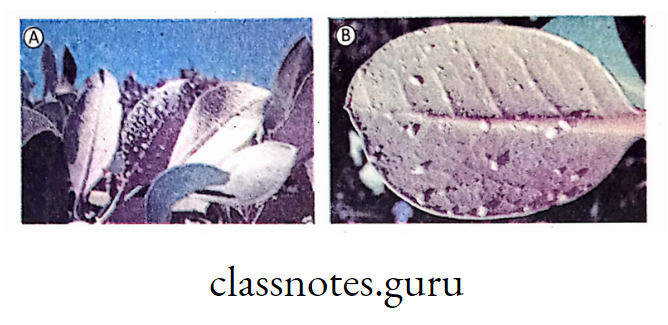
Salt storage—Within the cells, salt is stored in the vacuole (vacuolization) whereas organic solutes are stored in cytoplasm. The vacuolar membrane (tonoplast) of cells of Sundri has a modified lipid composition to prevent leakage of Na+ back to cytoplasm.
In the leaves, there are large vacuoles where the salt is stored and later eliminated during shedding of leaves.
Water conservation—There are thick leaves with leaf hair, waxy cuticle to prevent water loss by transpiration so that spit concentration is maintained in dilute form.
Camel’s Ability To Withstand Extreme Water Loss And The Shape Of Rbc In Camel :
Osmoregulation and Thermoregulation:
Camel can travel great distance in desert without food and water for several days (almost a week). Hump is the source of energy and water. There are two types of camel-(l) With one hump (Dromedary) found in Middle East and Africa and (2) With two humps (Bactrian) found in Central Asia (Baby camels are born without any hump).
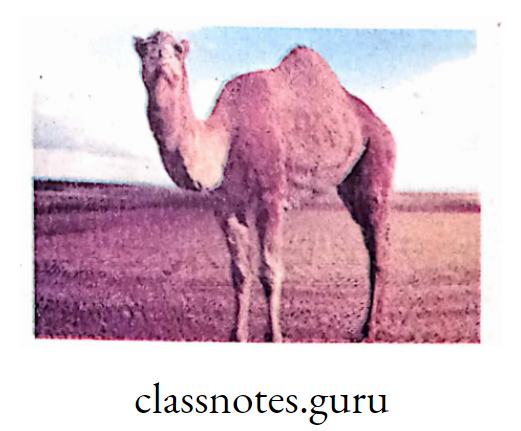
Hump stores fat (about 10-15 kg) and also protects other tissues from heating due to sunburn. Hump fat is metabolised to produce water (about 1111 gm of water per 1000 gm of humpfat).
There are several adaptive features in camel to withstand extreme water loss and thus to adjust osmoregulation and thermoregulation.
Thick skin—Camel’s thick skin insulate them from intense heat radiated from desert sand.
Tolerance of fluid loss-Camels can lose up to25% of their body fluid without showing any sign of dehydration. This provides; an extra tolerance against long term water shortage. However, they can tolerate water loss up to40% of their body weight.
Formation of dry faces—Camel reduces water loss by removal of almost dry faeces (used as fuel by Bedouins directly without further drying) by active absorption of water and salts in colon.
Body temperature and sweating—Camel can regulate body temperature in a very special way. Their body temperature ranges from 34°C at dawn upto a steady increase.to 40°C
by sunset and cool off at night again. Sweating will occur beyond 40°C temperature.
This type of unusual tolerance in extreme heat helps them to preserve approximately 5 litres of water per day.,
Role of kidney—Kidney decreases glomerular filtration rate (GFR) and can reabsorb water tremendously. If they don’t drink water, urine volume will be 500 gm/day. On the other hand, if water is abundant urine volume may go up to 7 litres/day.
After reabsorption,the urine becomes as thick as syrup and has twice the salt content of sea water.
Role of nostrils—During expiration water vapour is trapped in the nostrils and reabsorbed into the body to conserve water.
Food habit—Camel eats green herbs and thus can ingest sufficient moisture to maintain body’s hydration.
Shape of RBC and Osmoregufation :
RBC of camel is nucleated, oval in shape (found in no other mammal) which resist clumping in waterloss (dehydration). Plasma volume is maintained by absorbing tissue fluid, so that circulation is not impaired
Water is scarce in desert and needs to be stored in large amount when available. Amazingly, camels can drink upto 150-200 litres of water at once, (A 600 kg camel can drink 200 litres 3 minutes). They do this to compensate previous fluid loss.
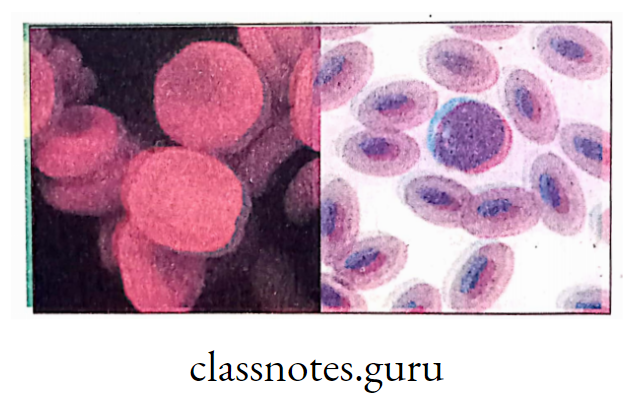
Drinking so much of water in such a short time could be a problem that may induce water intoxication and severe osmotic probiem. The oval shape of camel’s RBC and their ability to swell upto doub adjust this situation.
Water is absorbed very slowly through their stomach and intestine, allowing time for equilibrium. Moreover, RBC can swell upto 240% of normal size without bursting (while other species can only go upto 150%).
NCERT Class 10 Science Notes: Evolution and Adaptation in Plants and Animals
Behavioural adaptive features :
Problem-Solving In Chimpanzees :
Termites are favourite food of chimpanzee. They take a twig of a tree, remove the leaves from the twig. Then they use the stick like a “fishing rod” to “fish” the termites. Chimpanzee inserts the leafless stick (twig) into one of the holes in termites mound, waits for a moment, then slowly pulls it out.
The termites sticking to the twig are eaten up by chimpanzee.
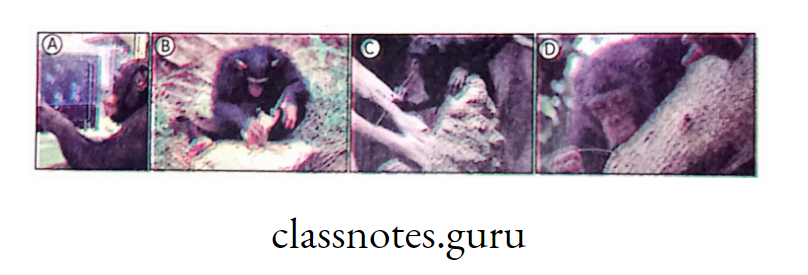
Chimpanzee also can crack open nuts using pieces of woods in a hammer and anvil” technique.
It has been also observed that chimpanzee eats leaves of medicinal plants when infected with certain parasites.
Communication In Honeybees :
Honeybees go out to locate food source.’ A honeybee returns to the hive after successfully locating a source of food. The foraging worker bee dances at a dance floor close to the entrance of bee hive.
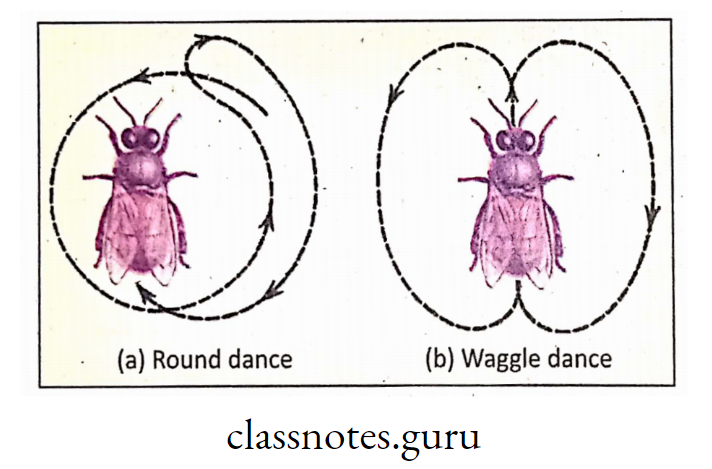
The worker bee (collector). is a sterile female who performs a set of skilful movements (manoeuvres) on the honeycomb that resembles a figure 8 (8) while waggling her abdomen. Based on the way of her dance, other bees are able to leave the hive and quickly locate the food she is dancing and the duration
source.
